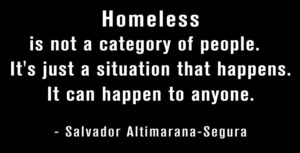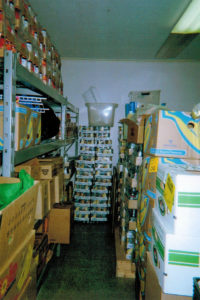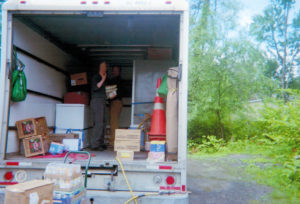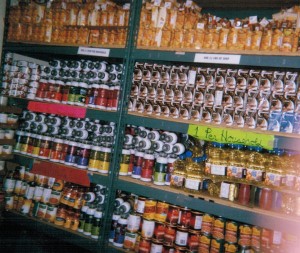January 6, 2021 at 7:47 pm


If you read my last post – “Food Pantry Rules” – you may have thought you were in some time warp. Travel had returned you to about 2010.
Well, not really.
The pandemic changed many details but the bones of a food pantry event are the same.
The volunteers and the people who shop at the pantry are the same.
Everyone comes together looking for groceries but often, they want and need far more.
Food pantry lines get longer every pantry day because people, families, struggle with change they didn’t ask for.
They are rewriting their destiny stories without a road map or instructions.
A number of people in the food pantry, both shoppers and volunteers, didn’t know about food pantries until circumstances set up a situation where they suddenly looked around and realized they were in a car in a long line waiting for food.
There is a name for this category: SITUATIONAL POOR.
A person fits into the situational poor category when she lands in a situation created by an event such as a hurricane, fire, flood, pandemic, or other disaster which destroys the home, car, job.
Food pantries offer much – peace, community, spiritual connection, groceries.
A food pantry in the basement of a church is a cross between a church and a busy pizza place.
A food pantry in a line of cars in a pandemic is reminiscent of the mass food distributions we held periodically in New York State after the collapse of the economy in 2008.
A line of cars filled with people needing food wraps around the block, down the road, and even further.
A whistle blows.
The cars begin to move. A volunteer puts a bag (s) of food in each vehicle.
Everyone wears masks.
There are still food pantries where people show up to a church and receive a bag of groceries.
But, whether the food is distributed to hungry people in cars or to hungry people walking to a building, a food pantry distribution is not a program. It is a community made up of those who gather the food and distribute it, and those who receive it. The process of distributing the food to people creates a change in everyone.
The experience does not heal a person. Nor does it change the story. It does not offer therapy. The experience itself is a conduit for each person’s own spiritual growth and change.
Never once when I was involved in a food pantry did I kid myself into thinking that I was winning the war against hunger. And, I do not kid myself now.
I know this food pantry food distribution experience does not end hunger. Instead, it offers food for several meals. And, that is all.
Ending hunger is another matter altogether.
I do feel, though, that the rules are changing. The pandemic experience is altering the hunger situation dramatically, at least. The pandemic experience is altering the hunger situation permanently.
“How is that?” you ask.
The pandemic has changed how our food is grown and distributed. Food pantries are a link in the food distribution chain. This chain now looks different. The link connections are different.
“How is that?” you ask.
For one thing, the restaurant industry is different.
Food production and distribution is different.
I do not think we know yet just what the fallout is. We have yet to live out the end of this story. We’re living and experiencing the future. For some, it is hard to see the big picture because the changes have not yet come around for each of us to see and experience in our daily lives.
In any event, the Pandemic is not us what we think. Our opinions and preferences don’t count for much here.
One thing is certain, our future is destined to be different from a future without a Pandemic. Another thing is certain for me: We can never return to our past.
We are all destined to experience a new Pandemic future.
Whatever the future brings, we need to keep on feeding the hungry in whatever way that works.
Thank you for reading this blog post. Please forward this article to your preferred social media network.
Share it with your friends.
Thurman Greco



January 5, 2021 at 8:53 pm

A food pantry is what it is because of three things:
the economic situation at the moment
the volunteers
the people who shop there.
The people come together looking for groceries but often, they want and need far more.
While the coronavirus pandemic rages, the food pantry lines get longer every pantry day because people, families, deal with change they didn’t ask for.
In short, they are rewriting their destiny stories without a road map or instructions.
A number of the people in the pantry, both shoppers and volunteers, didn’t know about food pantries until circumstances set up a situation where they suddenly looked around a room and realized where they were.
There is a name for their category – SITUATIONAL POOR.
A person fits into the situational poor category when s/he lands in a situation created by an event such as a hurricane, fire, floor, pandemic, or other disaster which destroys the home, car, job.
Pantries offer much – peace, community, spiritual connection, groceries. I always think of a food pantry in the basement of a church as a cross between a church service and a busy pizza place.
A food pantry, and those connected with it, are not a program. They are a community. As volunteers, all we really do is open the door. As all the hungry people walk through the door, they undergo a change somehow.
Each person in a pantry, in whatever capacity, has experienced rejection in some way – too young, too old, too crazy, too sick, too poor, not poor enough.
The food pantry experience does not heal a person, nor does it change the story.
The food pantry experience does not offer therapy.
The food pantry is, instead, a conduit for each person’s own healing.
FOOD PANTRY RULES
Sign your name in the register as you enter the pantry.
Find a place in line.
Do not crowd or block the door to the pantry room.
No more than 2 shoppers are allowed in the pantry at one time.
No more than one new shopper is allowed in the pantry at one time.
Shop for a three-day supply of food for everyone in your household.
Place your selections on the table as you shop.
Respect the restrictions on certain foods.
Finish your shopping in 10 minutes.
Once you begin to bag your groceries, do not continue to shop.
Because the food availability is different each time you shop, it is best to visit the food pantry weekly.
Thank you.
Thurman Greco
P.S. The rules may be different at the pantry where you shop. Each food pantry is different. The space is different. The times the pantry is open is different. The management is different.
These specific rules were used in the food pantry I managed where the people were many, the space small, and the hours few.
Please forward this article to your preferred social media network.
Share it with your friends.




December 23, 2016 at 1:56 am

“When we talk cooking and eating, we are talking love, since the entire history of how a family loves – when and how they learned to love – can be told in most kitchens.” – Marion Roach Smith
The first year a person uses a food pantry for primary shopping, Christmas is a holiday gone wrong. After several years, Christmas becomes whatever the household can make of it. The adjustment is, for some, difficult and for others more difficult.
The difficulty lies, mostly, in the ability to get food items considered “traditional” by a household when no money is available to purchase them in a grocery store.
Once, I heard some pantry shoppers talking in the line about holidays past. Their conversation centered around people celebrating by eating too much delicious food and visiting with relatives, friends, neighbors while swapping stories, catching up on the news.
For more and more people living in poverty, this just doesn’t happen. Both households and individuals find themselves unable to finance the expense of the holiday event.
Not only can they not afford the food, more and more people no longer have the table to sit at, the chairs to sit on, and the stove to cook the food. Recipes, pots and pans, china, silverware, crystal are long since gone. Eating without a kitchen is the way of the modern household living on a minimum wage.
With luck, today’s struggling class household will have the gas to get the car to a soup kitchen. Otherwise, it’s going to be a regular day with a meal prepared in a crock pot, or on a hot plate. The economic situation for some is that just to take the day off and still be able to buy groceries the next day is more a goal than anything else.
Realities faced by the hungry pantry shopper weigh on my shoulders every day of the year. This weight keeps me squirreling away food so the pantry shelves can be stocked for celebrations with canned soup, canned gravy, potatoes, stuffing mix, canned green beans, cranberry sauce, chicken broth and all the fruits and vegetables that can be gotten at food drives and the food bank. Storeroom space and a few freezers at the food pantry are essential.
Pantry volunteers have a difficult time just keeping up with the ever increasing client census. Those with a stable shopper base, a large storeroom and connections can begin scrounging in July to set aside food. It’s extremely challenging to get several hundred or a thousand of an item in the summer and store the food until December.
After several years and several holidays, the food gatherer in the household becomes, if time allows, more skilled at scrounging for food in both the pantry and the grocery store. The difficulty lies, mostly, in the ability to get food items considered “traditional” by a household when no money is available to purchase the items in a supermarket.
While distributing food, I mentally predict who’s going to be successful at scrounging and gathering by the sound of the automobile as it’s driven into the parking lot of the pantry. A successful holiday dinner depends on a working automobile, time available between jobs, and the energy to sustain the search.
Transportation challenges, disabilities, and serious illness in the family can defeat all efforts.
Thank you for reading this article.
Please share this story with your preferred social media network.
Thurman Greco
Woodstock, NY
Book Update: “A Healer’s Handbook” has been published and is available on Nook and Kindle! It will be available in the paper version in early January. If you order it now, it will be mailed directly to you upon publication.
More information about this book can be found on Thurmangreco.com.
Publication of “The Unworthy Hungry” is now scheduled for January 2018.
Thank you for your support and your patience. Now that “Healer’s Handbook” has been published, there will be more frequent and regularly published articles on all blogs.
Thanks Again













